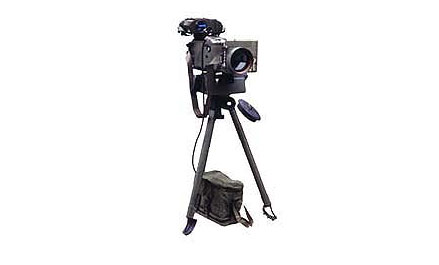The Night Observation Device, Long-Range (NODLR) allows infrared thermal viewing of night or daylight targets during all weather conditions. Infrared thermal technology allows the viewer to 'see' heat sources, greatly improving observation in certain conditions such as fog and darkness. The NODLR can determine data on potential targets such as range, azimuth, and elevation. It may be mounted on a tripod and operated with a battery pack, or mounted on a vehicle (for static operation only).
The NODLR system consists of an infrared Thermal Observation Device (TOD), a Laser Range Finder (LRF), and a goniometer. These components are described in the paragraphs below.
The Thermal Observation Device (TOD) detects varying levels of infrared energy within its field of view. It is then able to generate an image of the scene and display it on a small monochromatic display. This image is viewed by the operator through the eyepiece.
The Laser Range Finder (LRF) provides rapid and highly accurate range determination (distance to targets). This data can then be passed to soldiers operating weapons systems. Using the LRF greatly increases the first round hit probability on targets. The LRF is mounted on top of the TOD.
The goniometer is a very accurate elevation and azimuth scaled tracking head. It allows the TOD and LRF to rotate manually in azimuth (left and right) and elevation (up and down). It is fitted with calibrated scales so that when a target is located in the centre of the TOD screen the azimuth bearing and the elevation angle can be read off the goniometer scales. This data can then be passed to soldiers operating weapons systems.
The NODLR also comes with a tripod, a battery pack, two soft carrying cases for portable operations and two hard transit cases for long-range vehicle transportation.
There are currently 230 NODLR in-service. Plans are in the works to upgrade all these units. The improvements will keep the NODLR in service for another 10 years by improving systems reliability and sustainability as well as producing a quieter system with increased battery life.
Specifications
Weight: 25.3 Kg (with all accessories)
Narrow Field of View (NFOV): 3° x 2° (53 x 35 mils)
Wide Field of View (WFOV): 10.8° x 7.2° (190 x 127 mils)
Apparent Magnification: NFOV: 8.31x; WFOV: 2.42x
Range Focus: <30m to infinity
Detector Type: Mercury-Cadmium-Tellurium (HgCdTe)
Monocular Eyepiece Apparent Magnification: 8x
Resolution: 36 Line Pairs/mm
Goniometer Azimuth Range: 6 400 mils
Goniometer Elevation: ±400 mils
Number in Service: 230
Entered Service: 1989
NODLR
Canadian Forces
